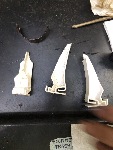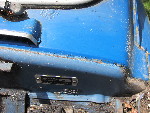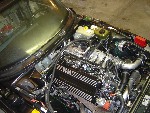 |
 |

[Subscribe to Daily Digest] |
When I use to auto-x a lot I used this as a guide at times. It's a tad old, but most of it still holds true.
This article reviews some R-compound tires generally available right now. This isn't a "tire test." The opinions expressed in this article are based on conversations with owners, dealers, and manufacturer's representatives and a lot of reading. Your experiences will be different. For instance, I was in the market for tires for competition (Solo I and II). Thus, I placed the most importance on performance. This is different from tires I would choose for driver education weekends (DEW). Long time readers will know that I don't believe R-compound tires are necessary for the "E" part of a DEW. Then again, I think Mont-Tremblant's short course is a better (and smoother) pedagogical tool than the long course. For a DEW, speed is not important (these are not timed events), but handling and tread wear are.
First, a word about tread wear ratings:
Moulded onto the sidewall of every tire is a tread wear rating. These ratings aren't perfect, but they give a rough indication of tread life. My interpretation of the readings (which isn't the same as the official one) is as follows: > 300 This is the last set of tires you'll ever have to buy for this car. ZZzzzzz.
250-300 You will want to replace these tires due to old age, not wear.
150-250 High-performance street. If they could only last another event . . .
100-150 Ultra-High-performance. Another season of tread life would have been nice.
<100 R-compound race tires. Tires and rims are a significant cost of vehicle operation
Although manufacturers don't like to say this, there is a pretty much direct correlation between handling and tread life. It may be no longer technically true, but the relationship still holds when comparing tires of the same type. Yes, there have been improvements in tread compounding - an "all-season high-performance tire" would have been an oxymoron a few years ago. However that technology has given improvements across the board . . . an ultra-high-performance street tire like the Bridgestone S-02 offers unbelievable performance.
What is a track tire?
I've arbitrarily divided the tire market into four segments. I'm only looking at tires in the last segment.
Street performance tires
These are codewords for "Good tread life" which are codewords for "Hard compound" which means "Less performance" - still very good, though. These are tires that probably won't see a track event. They usually have excellent wet-weather performance (unlike some R-compound tires). Some are even all-season now. Tread wear ratings generally greater than 250. Example: Toyo Proxes U-1.
High-performance street tires
Driver education events can be done in almost any tire, except a brand-new one. Once students are comfortable driving by themselves, though, a common complaint is the search for better tires. Just keep in mind the general rule that the higher the performance, the higher the cost and the lower the tread life. Careful selection can yield a tire with excellent handling characteristics, but with lower limits and much longer life than more expensive tires. Make sure the tires are well scrubbed in before use on the track or you may chunk (ugh!) the tires. Tread wear ratings 150-250. Example: Yokohama AVS Intermediate.
Ultra high-performance street tires
This is the expensive part of the tire market. The tires are very expensive, and they don't last very long. They all handle very well and are the ultimate overall tires. Did I mention these things are expensive? Fun, though. Tread wear ratings 100-150. Example: Bridgestone S-02.
R-compound "street" tires (Track tires)
R-compound tires arose when racing sanctioning organizations decided that some classes of racing must run on "street tires," usually defined as DOT approved. Certain tire manufacturers saw a window of opportunity, giving racers tires that were the same as a "usual" street tire, but moulded with very soft rubber for great traction (and short tread life). After a while, the competition heated up, and now R-compound tires bear little relation to their street brethren other than the name on the sidewall. R-compound tires are designed specifically for the track. They grip. They have stiff sidewalls. They may even cost less than high-end street tires. With a good alignment, they are the most cost-effective performance upgrade you can make to your car. (Think about that for a second.)
Do I need Track tires?
Do you feel the need to go faster in corners, brake harder, and spend more money?
You do? Well, then do you do one or more of the following?
- drive on a track three or more times weekends annually
- Solo II/autocross
- Solo I/time trials
If the answer is again yes, then you probably want to consider R-compound tires. If any answer is no (including the "spend more money" part), then you may want to reconsider. If all the answers are no, then you don't need track tires!
If your car is heavily modified, why bother with R-compound tires? Go straight to out-and-out racing slicks. R-compound tires were designed to meet a specific rule in certain classes of racing - namely to use DOT-approved street tires. If you don't have that restriction, slicks may be a viable alternative.
Hint: A second set of tires usually involves a second set of rims. Heavy-duty steel wheels of the type used by the stock car crowd are much less expensive than alloy wheels, though heavier. Almost any size and offset are available. Used rims are also an option, but should be carefully inspected. If the brake and body clearances are there, smaller diameter rims (15" instead of 16", for example) are usually cheaper (smaller diameter tires are cheaper, too).
What size do I get?
Quite often the best bet is to stick with the manufacturer's original or optional sizes. OEM rims are quite often available used to save money. For extensive track use, the optional sizes are probably better. If the car's suspension has been extensively modified, sizing is often more of a question of what is available and can fit. Remember that wider tires need more horsepower. Having too much tire for a given application is possible.
A speed tip that may, or may not, work for you: Given that you're going to be using these tires just on the track, why worry about speedometer readings, ride, ground clearance, or fuel economy? Go with a lower profile tire on the same diameter rim, instead of +0 or +1. For example, on my 924S: Type (Comp T/A R1) Size Diameter Tread Width
+0 size: 205/60 x 15 24.6" 6.8"
+1 size: 205/55 x 16 24.8" 7.3"
lower profile: 205/50 x 15 23.0" 7.3"
(Stock size is 195/65 x 15. Unmodified suspension and fenders restrict tire width to 205.)
Conventional wisdom (and the factory option) is to go with the +1 size, giving about the same overall diameter, but on a larger rim. This is true if you need to worry about speedometer readings, rides, ground clearance, fuel economy, etc. This makes the sidewall shorter (by 0.4" in this example), thus stiffer, thus better handling.
The lower profile, however, also makes the sidewall shorter (by 0.8"), and stiffer. It also lowers the car by that amount, lowering the centre of gravity and getting all the good things that come with that without buying new springs.
Finally, the lower profile tire gives the same effect as a numerically higher final-drive ratio (greater acceleration, lower fuel economy). Given the stock ratio is 3.889:1; the 205/50's give an implied final drive of 4.159:1. Cruising at 100 km/hr will take a 230 additional rpm (a 7 km/hr error), but this isn't important on the track. What is important is the car will pull just a little bit harder coming out of corners.
So, almost an inch drop, better handling, faster acceleration compounded with the higher absolute grip of the R-compound adds up to cheap track performance improvement. Do NOT use this combination on the street, though. Reducing ride height without increasing spring rate will cause bottoming out on bumps, which may damage expensive components. (One 944 owner had his oil pan ripped out by an errant rock, for instance.) Like any performance improvement, there are tradeoffs.
One can carry this even further and use 225/45 x 15 tires (only available from Hoosier). These have a 22.8" ride height an 8.2" tread width, but will stick out beyond the fenders and would work best with wider rims, possibly with a custom offset.
Do tires need heat-cycling?
BFG Team T/A tests show heat cycling gives 50% greater track tread life than untreated R1's. Both untreated and heat-cycled had equal lap times, with the heat cycled being more consistent. Different tires will have different results.
What is heat-cycling?
The idea is to bring the tire up to operating temperature gently the first time the tire is used, heat the tire through, and then cool it gradually. First, increase cold pressure 4-6 psi. Then, there are two methods; I don't know which is best. One is to drive 150 continuous highway kilometres. The other is to drive about ten minutes on the track with the objectives of bringing the tire up to operating temperature gently and heating the tire completely - not low lap times. Then take the tires off the car, drop the pressure 4 psi below normal, and store in a clean, cool, dry place away from the sun (24 hr. minimum, 48 hr. recommended). Force-cooling should not be used.
Do I need to shave my tires?
If you are racing, yes. Even after a good initial heat-cycling, unshaved tires will eventually be slower than shaved tires, and can be damaged by early over-enthusiastic use. R-compound tires moulded to full tread depth must be shaved before use. However, most R-compound tires are made with special moulds and do not need to be shaved to function. Shaving still offers an immediate performance benefit, but most owners prefer to take advantage of the additional tread life, albeit at lower g's. Care must be taken to avoid chunking and/or the development of undesirable tread patterns if the tire is not shaved. (This was so common in one earlier tire that it attained the acronym EGOD - Evil Groove o' Doom.)
Shaved tires are not rain tires.
So, what tires should I buy?
As the old saying goes . . . "Speed costs money. How fast do you want to go?"
posted by 65.118.125...
 , Fri, 21 Apr 2006 08:04:21
, Fri, 21 Apr 2006 08:04:21
No Site Registration is Required to Post - Site Membership is optional (Member Features List), but helps to keep the site online
for all Saabers. If the site helps you, please consider helping the site by becoming a member.
 |
 |
 |
 |
 |



